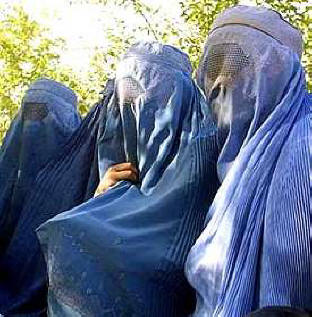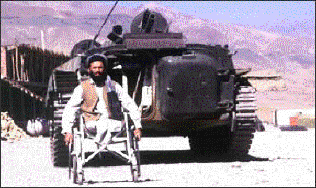Taliban War on Women
William S. Abruzzi
(2002)

Below is a petition that was emailed to thousands of people during the late 1990s.

The Taliban's War on Women
The government of Afghanistan is waging a war upon women. The situation is getting so bad that one person in an editorial of the times compared the treatment of women there to the treatment of Jews in pre-Holocaust Poland. Since the Taliban took power in 1996, women have had to wear burqua and have been beaten and stoned in public for not having the proper attire, even if this means simply not having the mesh covering in front of their eyes. One woman was beaten to DEATH by an angry mob of fundamentalists for accidentally exposing her arm while she was driving. Another was stoned to death for trying to leave the country with a man that was not a relative. Women are not allowed to work or even go out in public without a male relative; professional women such as professors, translators, doctors, lawyers, artists and writers have been forced from their jobs and stuffed into their homes, so that depression is becoming so widespread that it has reached emergency levels.
There is no way in such an extreme Islamic society to know the suicide rate with certainty, but relief workers are estimating that the suicide rate among women, who cannot find proper medication and treatment for severe depression and would rather take their lives than live in such conditions, has increased significantly. Homes where a woman is present must have their windows painted so that she can never be seen by outsiders. They must wear silent shoes so that they are never heard. Women live in fear of their lives for the slightest misbehavior. Because they cannot work, those without male relatives or husbands are either starving to death or begging on the street, even if they hold Ph.D.'s. There are almost no medical facilities available for women, and relief workers, in protest, have mostly left the country, taking medicine and psychologists and other things necessary to treat the skyrocketing level of depression among women.
At one of the rare hospitals for women, a reporter found still, nearly lifeless bodies lying motionless on top of beds, wrapped in their burqua, unwilling to speak, eat, or do anything, but slowly wasting away. Others have gone mad and were seen crouched in corners, perpetually rocking or crying, most of them in fear. One doctor is considering, when what little medication that is left finally runs out, leaving these women in front of the president's residence as a form of peaceful protest. It is at the point where the term 'human rights violations' has become an understatement. Husbands have the power of life and deathover their women relatives, especially their wives, but an angry mob has just as much right to stone or beat a woman, often to death, for exposing an inch of flesh or offending them in the slightest way.
David Cornwell has told me that we in the United States should not judge the Afghan people for such treatment because it is a 'cultural thing,' but this is not even true. Women enjoyed relative freedom, to work, dress generally as they wanted, and drive and appear in public alone until only 1996 -- the rapidity of this transition is the main reason for the depression and suicide; women who were once educators or doctors or simply used to basic human freedoms are now severely restricted and treated as subhuman in the name of right-wing fundamentalist Islam. It is not their tradition or ' culture,' but is alien to them, and it is extreme even for those cultures where fundamentalism is the rule. Besides, if we could excuse everything on cultural grounds, then we should not be appalled that the Carthaginians sacrificed their infant children, that little girls are circumcised in parts of Africa, that blacks in the deep south in the 1930s were lynched, prohibited from voting, and forced to submit to unjust Jim Crow laws.
Everyone has a right to a tolerable human existence, even if they are women in a Muslim country in a part of the world that Americans do not understand. If we can threaten military force in Kosovo in the name of human rights for the sake of ethnic Albanians, Americans can certainly express peaceful outrage at the oppression, murder and injustice committed against women by the Taliban.
STATEMENT:
In signing this, we agree that the current treatment of women in Afghanistan is completely UNACCEPTABLE and deserves support and action by the people of the United States and the US Government and that the current situation overseas will not be tolerated. Women's Rights is not a small issue anywhere and it is UNACCEPTABLE for women in 1998 to be treated as subhuman and so much as property. Equality and human decency is a RIGHT not a freedom, whether one lives in Afghanistan or the United States.
* * * * *
T
"When
the Taliban forces took over Mazar-i-Sharif, the last stronghold of the
opposition coalition, reports ensued of summary executions, the banning of
work and education for women, and the systematic
beating of young men for shaving off their beards." . . .
"There
has been a recent escalation of terrorist activities by separatist groups
that are supported by militant Islamic groups, such as the Taliban. Recently, the city of Kasha was effectively sealed to outsiders after eight
policemen were found in their
barracks with their throats slit." . . .
"Iran holds the Taliban responsible for the disappearance of dozens of Iranians, including 10 diplomats, during fighting in Mazar-i-Sharif in August." . . .
"Amnesty
International reported that hundreds
of Afghanistan's Shiite minority were
massacred by the Taliban militia when
they overran Mazar-i-Sharif. Eyewitnesses, including United Nations officials, aid
workers, and Western diplomats, say the
number of massacred
Shiites reached as many as 6,000 or 7,000.
Thousands of Shiite Hazaras, mostly
males,
were killed
in front of their families. The
Hazaras, a Mongol people who form an estimated 15 percent of the
population of 18 million, have resisted Taliban offensives for the past
four years." . . .
"A
senior diplomat who has interviewed dozens of Hazara families says, 'Young
men over
16 were
brought out of their houses into the streets to have their throats slit in
ritualistic killings. Younger boys
had both hands chopped off at the wrist.'
An aid worker said Hazara bodies were left in the streets for days, and
people trying to escape from
the city were shot. Another
aid worker says, 'they [the Taliban militia] were mutilating children and telling them, 'You will never fight us again.'"
*
* *
* *
As these quotes from World Press Review clearly indicate,
the above petition presents a serious misrepresentation
of the political situation in Afghanistan.
The Taliban did indeed impose a harsh and
brutal regime in Afghanistan.
However, women were not the only victims of Taliban rule. Men,
women and children
all
suffered under the Taliban
(as they have in Yugoslavia, Iraq, Rwanda, Sierra Leone and other places
where brutal regimes exist).
It was
all
of the people of
Afghanistan --men,
women and children--
who were the targets of Taliban violence and brutality.
However,
the
forms that such violence took in Afghanistan --and that it takes in
politically repressive societies generally--
differed
by gender. Men and boys are more likely to be killed outright or to
have their hands and
arms
removed
in order to prevent
them from taking
up arms or
from
being able
to support their
families. Women, on the other hand, are more likely to be forced
into servile labor or raped. Both outcomes are horrendous; how
does
one determine whether
one form of repression is the worse
than the other?
|
Afghan Man with One Leg
|

Afghan Man with No Legs |
By
focusing exclusively on the treatment of
women in Afghanistan and by viewing the Taliban's activities in narrowly
defined gender terms, the above petition raises several important issues:
1. Focusing exclusively on the treatment of women serves to narrow and parochialize our understanding of the situation in Afghanistan. In this regard, those who distributed the above petition focused on only one aspect of the Taliban’s activities and viewed those activities out of the larger context within which they occurred.
2. By focusing exclusively on women and by viewing the Taliban's treatment of women in specifically gendered terms, those who distributed the petition failed to systematically understand and explain the many other behaviors of the Taliban that had nothing to do with women, including the Taliban's trial of eight foreign aid workers, their support of Osama bin Laden, their destruction of ancient Buddhist statues in the Bamia Valley (see photos below), and their ban on dancing, music, films, television and the Internet, to say nothing of their slaughter and mutilation of thousands of men and boys. By focusing just on the women, Westerners in general, and feminist organizations in particular, failed to see the “forest through the trees”. As with any special interest group, feminist organizations chose to focus exclusively on the facts and issues that fit their particular concerns. However, there are other, more comprehensive explanations of what took place in Afghanistan that are not gender based and that explain the treatment of men and women and the other activities of the Taliban within a broader theoretical and empirical context. These explanations are more compelling, then, in terms of their ability to systematically explain the rise and behavior of the Taliban. To what extent do we prevent the development of a fuller, more complete understanding of a situation, such as the activities of the Taliban, by focusing on the explanation and analysis provided by special interest groups? And to what extent should we be careful to examine a particular group's claims, and even its data, in order to be sure that we are not being unduly influenced to support that specific group's agenda?
|
3. Photos showing Taliban mutilation, torture and killing of men
have not received as much attention by the media or by those
promoting the “Taliban War Against Women.” (see
Man
Imprisoned by Taliban)
Is it equitable to protest the forced wearing of the Burqa,
the closing of girls schools, etc. but not to equally protest the
mutilation, torture and killing of men and boys? Does focusing exclusively on women constitute a sexist bias
in news reporting and in human rights activity?
What would the reaction be if the situation were reversed
-- if only the mistreatment of men in Afghanistan was
reported and protested?
|
Afghan boy whose arms were amputated by the Taliban |
|
|
Destruction of the Bamian Buddhist Statues
A Buddhist Statue in the Bamian Valley
|
4. At the center of the storm over the Taliban treatment of women was the forced wearing of the Burqa. What is the context in which this garment is worn by women in Afghanistan? Women continue to wear the Burqa in villages throughout Afghanistan, even though the Taliban are no longer in power, and the Burqa is worn by many women in neighboring Pakistan, where the Taliban did not and do not rule. Moreover, even during Taliban rule, secret beauty parlors, such as the one in the photo below, continued to exist. Western dress and the employment of women outside the home was largely limited to the larger urban areas in Afghanistan, such as Kabul, where ten years of Soviet rule prevailed. Soviet influence did not penetrate very deeply to the many small villages and towns scattered throughout the country where more traditional social life prevailed. Was the "liberalization" of Afghan social life, then, an indigenous development, or was it the result of outside interference in Afghan affairs? To what extent was the Taliban's rise to power and their various decrees a conservative reaction to Soviet and American interference in Afghan society (as was the rise of the Maccabees in ancient Israel)? And if women and men are expected to dress and behave differently in public, is this an Afghan issue or is it an international issue involving Westerners and Western-dominated organizations? How different is this situation from Europe and the U.S. where men and women are also expected to dress differently and where men but not women, for example, are permitted to go topless in public? Is our attempt to institute change in Afghanistan and other Muslim countries different in principle from the attitude and reaction displayed by the American tour group that went to Iran (see Tourism)?

Beauty Salon in Kabul during Taliban Rule
5. Special interest groups act in their own interests and adhere to values and beliefs that both promote and legitimize those interests. It is not the role of the anthropologist to accept or promote a particular interest group's beliefs and values, but rather to examine those beliefs and values (i.e., their emic perspective) in order to determine to what extent they serve the interests of the group in question, whether that group consists of Yanomamo warriors, evangelical Christians, corporate executives, Islamic fundamentalists, environmentalists or Western feminists. To the extent that Western feminists highlight the maltreatment of women in Afghanistan and elsewhere, they promote and legitimize their cause in the U.S. and Europe. Maintaining a sense of siege or crisis is a common political strategy employed by social movement organizations. Contemporary environmental organizations, for example, frequently portray environmental issues such as overpopulation and global warming as impending crises in an effort to enhance their legitimacy and to increase membership and fund raising. This strategy of crisis --sincerely believed in by those committed to a particular cause-- has been used throughout history by individuals and groups on all sides of the political spectrum.
6. To what extent also might Western opposition to particular cultural practices in non-Western countries be perceived as an extension of Western neocolonialism? Peoples throughout history have resisted norms of behavior imposed on them by the dominant societies of the world. The rise of the Maccabees in Judea during the second century BCE was a result of Greek insistence that Jews adhere to Greek ritual practices, while the Jewish revolt against Rome in 132CE was sparked by Roman attempts to ban the practice of circumcision. The rise of Islamic fundamentalism throughout the Middle East is in large part a reaction to Western economic and political dominance in the world. Our own revolution was caused by American colonists' resentment of British colonial domination. Has the U.S. now become the dominant power trying to impose its norms of behavior on the rest of the world? To what extent might our perceptions and policies regarding the rest of the world reflect our self interest rather than those of the people in Afghanistan and elsewhere, despite our statements to the contrary?
Many Americans are critical of our behavior towards the Indians. The U.S. Government, with the help of various religious and social organizations, forced the Indians to abandon social and religious practices that were different from the American mainstream, even though they were important to the peoples themselves? We forced them to adopt the American way of life instead. Most Americans at the time believed that these policies were in the Indians' best interest. The Indians naturally resisted our pressures, and many Indians resent us today for our behavior then. Is our behavior with regard to non-Western peoples today substantially different from our behavior towards the Indians? Our perception of the behavior of peoples in other countries today, like our perceptions of Indians 100 years ago, is quite different from the perceptions held by the people themselves. This includes, for example, our attitudes towards population control and female circumcision (see North Waging Culture War against South), as well as our views of the role of women in Muslim society (see Jihad's Women, and Allure Must Be Covered). Westerners (including Americans) today are also just as convinced of the rightness of their perceptions and policies towards people in non-Western societies as were most Americans about the rightness of their behavior towards the Indians. And, like many Native Americans, millions of people throughout the world resent our claim of moral superiority and our insistence that they live by our standards, which is why people like Idi Amin, Sadam Hussein, Moammar Kaddafi and Osama bin Laden are often viewed as heroes in many parts of the developing world.
* * * * *
|
|
|
|
|





